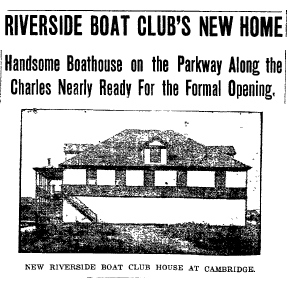By: Richard Garver
Riverside Boat Club’s boathouse turned 100 years old last month. Its construction is closely linked to the transformation of the Charles River into a park system at the turn of the 19th Century. To that point, the river’s Cambridge shore between the Brookline (B.U.) Bridge and Watertown was a series of tidal marshes and mud flats, punctuated by industrial sites like The Riverside Press and the adjacent Cambridge Electric Company, between which was wedged Riverside 1891 boathouse, Harvard’s coal yards, and the Watertown Arsenal. The river rose and fell at least five feet with the tides, sweeping through bridge pilings like a mill race. In 1905, a Riverside rower was quoted as saying that the club members “find occupation for their leisure moments fishing Harvard oarsmen out of the river” when they fetch up against the Western Avenue Bridge. “There was a time when a rescue meant the present of a new sweater or a pair of rowing tights, but now it is scarcely ‘Thank you.’ ” At low tide the river became too narrow for two crews to race abreast.
In 1893, the City of Cambridge issued a plan to turn its riverfront into a recreational facility. It proposed that the river be dammed upstream from Craigie’s Bridge. The City would construct an esplanade between the West Boston (now Longfellow) bridge and the Brookline Bridge, a park and swimming beach above Brookline Bridge known as Captain’s Island (now Magazine Beach), and a tree-lined parkway to be called the Charles River Road that would run upriver past Harvard. To that end, the City acquired most of its riverfront by eminent domain in January 1894. The property takings caused the wholesale reconfiguration of the Cambridge rowing clubs. The Cambridge Casino, the forerunner of Cambridge Boat Club, was moved to a site opposite DeWolf Street to make way for the new parkway in 1895. The Harvard Rowing Club relocated the first Weld Boathouse to a new bulkhead in 1897. Harvard’s 1869 boathouse was demolished and its crews moved across the river to Newell Boathouse in 1901.
The assembly of the right-of-way for the Charles River Road, which would be renamed Memorial Drive in honor of those killed in World War I following its transfer to the Metropolitan District Commission in 1923, was impeded by the presence of The Riverside Press, but in 1901 the City acquired this section of the alignment. The taking included Riverside’s boathouse, with the implication that the club would have to relocate to a new site. The transformation of the river into a recreational lake was completed with the construction of the Charles River dam, authorized by the legislature in 1903 and operational in 1910.
Ironically, these waterfront improvements accelerated the demise of some Charles River rowing clubs. In 1906, Riverside Boat Club’s Cambridgeport rival, the Bradford Boat Club, moved its boathouse out of the way of the river improvements and the impending construction of a new Cottage Farm (the present B.U.) Bridge. The park commission served notice in the spring of 1909 that the club must either renovate its building or remove it from the park reservation. Bradford attempted to raise the money to rebuild within the new parkland but it was soon reported that, “It now looks as though (Bradford) have to vacate the location granted for the boathouse on the east bank of the Charles River just above the Cottage Farm Bridge owing to the lack of funds to meet the requirements of the park commissioners.” On the other hand, the BAA took advantage of the improvements. With the Charles River no longer tidal, in 1911 it gave up its floating boathouse on the Cambridge shore in favor of a new boathouse within the park just below the Grand Junction Railroad’s bridge at the site of the present Boston University boat house.
The Cambridge park commission permitted Riverside to continue to occupy its boathouse while planning went forward for the Charles River Road. It was still in use in the spring of 1911. At about 1:00 A.M. on May 2, a watchman at the Cambridge Electric Co. spotted a fire in the building and sounded the alarm. The blaze was visible for miles and attracted a large crowd. At one point it spread to the adjacent electric company coal bins, but was soon contained. A Riverside member who tried to salvage club equipment had to be treated for smoke inhalation. In less than an hour, the building had burned to the ground. The club lost its boats, including four eights, two doubles, two four-oared workboats, two fours, twenty or more singles, as well as a number of whitehalls. The fire also consumed seventy-five banners and trophies, including those for national championships won four years earlier at Worcester and in Saratoga in 1894. As a result, only three of the New England Amateur Rowing Association banners hanging in the boathouse date before 1912.
On May 5, a membership meeting instructed a committee to locate temporary quarters until a new boathouse could be constructed. The St. Alphonsus Athletic Association, which had recently opened a boathouse on the Boston shore just below the Brookline Bridge (August 2012 Riverside Press), invited the club to share it for the time being. Riverside considered purchasing Bradford’s old facility, but decided instead to build a new boathouse. On June 10, 1911, it held a fundraiser at the Scenic Temple, featuring moving pictures, music, illustrated songs and sketches. Winter quarters were rented on Massachusetts Avenue. By December, design work was underway and the Cambridge Park Commission was considering the club’s proposal for a site on a small spit of land between Pleasant and River Streets within the projected Captain’s Island Park. On February 12, 1912, Riverside was granted a twenty-year lease for the site.
The City of Cambridge, the owner of the building when it was destroyed, settled with the club for $7,000. With these funds in hand, Riverside filed building plans with the City in April, 1912. Construction on the new structure, the club’s present boathouse, was quickly under way. It is not clear what rowing activities were carried on that season, but under president Thomas Riley and vice president T. F. Toomey Riverside continued to conduct boxing tournaments, including its annual tournament in Cypress Hall on Prospect Street.
The new boathouse was completed in September 1912 at a cost of $7,600. Surrounded by mud flats that were soon to form the western end of Captain’s Island, it was a two-story, hip-roofed structure 50 feet wide and 70 feet deep resting of wooden pilings capped with concrete piers. The first floor housed the club’s boats as well as a training room, showers, lockers and a dressing room. The second was devoted to a large assembly and dance hall with a raised band area, still visible in its downstream corner, as well as a women’s room and a checkroom. The section of the Charles River Road and its supporting seawall between Western Avenue and River Street, the last to be constructed, were completed in 1914. Cambridge’s 1916 Atlas shows Riverside’s boathouse within the newly constructed riverfront parkland, adjacent to the men’s, women’s and boy’s bathhouses serving Captain’s Island.


